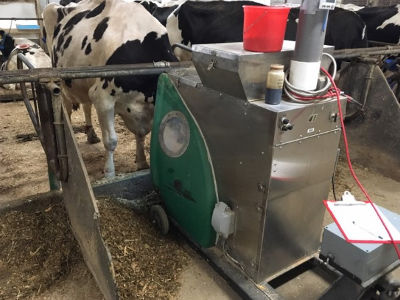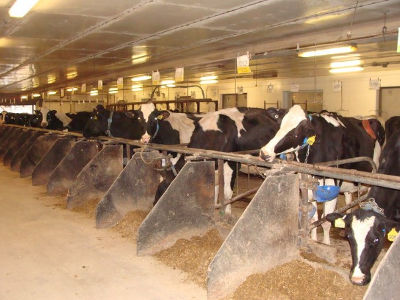By Jeff Mulhollem
The addition of 3-Nitrooxypropanol to the feed of dairy cows reduced their enteric methane emissions by about 25% in a recently published study — one in a series of Penn State studies of the investigational substance in the United States — which might be an early step toward it being approved for use in this country.
Often referred to as 3-NOP, the compound inhibits an enzyme that is crucial to the final stage of methane synthesis in a cow’s rumen. When 3-NOP is fed to cattle, their methane production is inhibited, explained researcher Alex Hristov, distinguished professor of dairy nutrition, College of Agricultural Sciences.
In addition to exploring 3-NOP’s effect on enteric methane emissions, the 15-week study conducted at the Penn State Dairy Teaching and Research Center examined 3-NOP’s influence on rumen fermentation, lactational performance, sensory properties of milk and the resumption of ovarian cycles in 56 lactating dairy cows. The results, which were published in the Journal of Dairy Science, confirmed those of other 3-NOP trials conducted at Penn State and around the world, according to Hristov.

Cows in the study at the Penn State dairy barns, to eat a sweet treat, put their heads in devices that measure methane they belch. The average dairy cow burps about 380 pounds of the potent greenhouse gas a year.
Compared with the control group, cows ingesting 3-NOP decreased their daily methane emissions by 26%, methane yield by 21% and methane emission intensity by 25%. Significantly, the investigational substance did not affect lactational performance of the cows and in fact increased their feed efficiency per unit of milk yield. The sensory properties of milk from cows fed 3-NOP and cheese made from that milk were not affected by treatment.
Methane — a natural byproduct of digestion in ruminants — is released by cows into the atmosphere mostly through belching. So, the results of 3-NOP trials are viewed by many scientists as critical, if the carbon footprint of dairy and beef cattle production is to be reduced to help slow climate change, Hristov noted.
“3-NOP is the only substance that has worked significantly in reducing enteric methane in cattle and not had unacceptable effects on milk production or quality,” he said. “We have tried many things in recent years — including essential oils, oregano and seaweeds — and they either have been ineffective in the long term or need to be investigated further.”

Penn State researchers have tried many things in recent years — including essential oils, oregano and seaweeds — to reduce enteric methane in cattle. But only 3-NOP worked without having unacceptable effects on milk production or quality.
Penn State researchers have tried many things in recent years — including essential oils, oregano and seaweeds — to reduce enteric methane in cattle. But only 3-NOP worked without having unacceptable effects on milk production or quality.
The Penn State research, including other studies completed or currently underway, is a critical step in the approval process for 3-NOP use in the United States and around the world, Hristov argues. “We have credibility because of our excellent facilities and our reputation for generating accurate, reliable data,” he said.
Dutch health and nutrition giant DSM, which has a patent on 3-NOP, already has applied to European regulators for authorization to sell the compound as a cattle feed additive. The company hopes to launch the product in the European Union by early 2021, followed by registrations in other regions such as Brazil, Australia, New Zealand and Canada.
The climate-change contribution of methane from cow burping — often incorrectly characterized as cow flatulence — has been the subject of considerable derision within the U.S., conceded Hristov, who is recognized as an international leader in assessing greenhouse gas emissions from animal agriculture. It is taken seriously in other countries, he explained, because the average dairy cow belches approximately 350 pounds of the potent greenhouse gas each year.

The climate-change contribution of methane from cow burping — often incorrectly characterized as cow flatulence — has been the subject of considerable derision within the U.S. It is taken seriously in other countries, said researcher Alex Hristov, distinguished professor of dairy nutrition, College of Agricultural Sciences.
“But methane from animal agriculture is just 5% of the total greenhouse gases produced in the United States — much, much more comes from the energy and transportation sectors,” Hristov said. “So, I think it’s a fine line with the politics surrounding this subject. Do we want to look at this? I definitely think that we should, and if there is a way that we can reduce emissions without affecting profitability on the farm, we should pursue it.”
3-NOP is expected to be economical, so farmers could afford to use it, Hristov pointed out. “It could be a game changer, but the question is, will the public accept it,” he said. “It’s a very small synthetic molecule that is metabolized very quickly and falls apart into compounds that are naturally present in the rumen of the cow. Consumer insight studies in the U.S., New Zealand and the Netherlands are showing considerable support for implementing 3-NOP.”
Others involved in the research at Penn State were Troy Ott, professor of reproductive physiology; Audino Melgar, doctoral candidate in animal science, in charge of the research; M. T. Harper, former graduate student; J. Oh, former postdoctoral scholar; F. Giallongo, former graduate student; and M. E. Young, former graduate student. Also part of the research team was Stephane Duval, DSM Nutritional Products, Basel, Switzerland.
Source: psu.edu